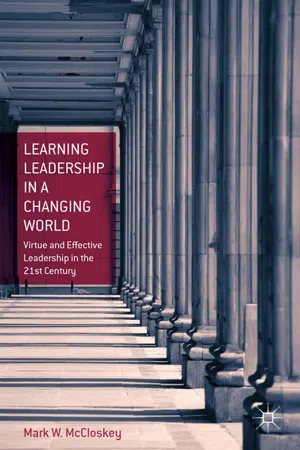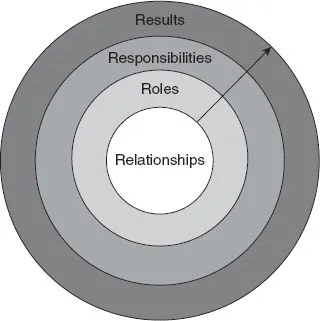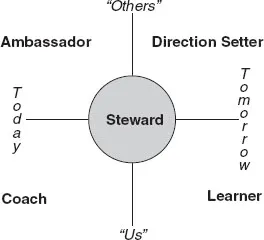
eBook - ePub
Learning Leadership in a Changing World
Virtue and Effective Leadership in the 21st Century
- English
- ePUB (mobile friendly)
- Available on iOS & Android
eBook - ePub
Learning Leadership in a Changing World
Virtue and Effective Leadership in the 21st Century
About this book
Learning Leadership in a Changing World provides direction and support in the form of the 4R Model of Leadership—a theoretically sound, conceptually straightforward, and educationally powerful framework.
Frequently asked questions
Yes, you can cancel anytime from the Subscription tab in your account settings on the Perlego website. Your subscription will stay active until the end of your current billing period. Learn how to cancel your subscription.
At the moment all of our mobile-responsive ePub books are available to download via the app. Most of our PDFs are also available to download and we're working on making the final remaining ones downloadable now. Learn more here.
Perlego offers two plans: Essential and Complete
- Essential is ideal for learners and professionals who enjoy exploring a wide range of subjects. Access the Essential Library with 800,000+ trusted titles and best-sellers across business, personal growth, and the humanities. Includes unlimited reading time and Standard Read Aloud voice.
- Complete: Perfect for advanced learners and researchers needing full, unrestricted access. Unlock 1.4M+ books across hundreds of subjects, including academic and specialized titles. The Complete Plan also includes advanced features like Premium Read Aloud and Research Assistant.
We are an online textbook subscription service, where you can get access to an entire online library for less than the price of a single book per month. With over 1 million books across 1000+ topics, we’ve got you covered! Learn more here.
Look out for the read-aloud symbol on your next book to see if you can listen to it. The read-aloud tool reads text aloud for you, highlighting the text as it is being read. You can pause it, speed it up and slow it down. Learn more here.
Yes! You can use the Perlego app on both iOS or Android devices to read anytime, anywhere — even offline. Perfect for commutes or when you’re on the go.
Please note we cannot support devices running on iOS 13 and Android 7 or earlier. Learn more about using the app.
Please note we cannot support devices running on iOS 13 and Android 7 or earlier. Learn more about using the app.
Yes, you can access Learning Leadership in a Changing World by M. McCloskey in PDF and/or ePUB format, as well as other popular books in Business & Business Strategy. We have over one million books available in our catalogue for you to explore.
Information
SECTION III
The 4R Model of Leadership: Relationships
This section introduces the framework of the 4R model of Leadership and explores the Relationships component of the model. The Relationships component of the model replaces Old Normal images of success with a fresh vision of effective leadership as virtue-based influence.
CHAPTER 8
The 4R Model of Leadership
Introduction
The New Normal has arrived, exposing the Old Normal leadership narrative and its supporting myths as inadequate. The Old Normal narrative must be replaced with a New Normal leadership narrative supported by a fresh set of images and vocabulary better suited to address the conceptual, moral, and emotional challenges of the twenty-first century. This calls for a shift in emphasis from Old Normal “best practices” that draw on an elite Leader’s charisma and technical–managerial competence to New Normal “next practices” grounded in virtue-based collaboration. The 4R model provides the conceptual framework to support this shift.
Introducing the 4R Model of Leadership
The 4R model provides a simple framework for conceptualizing effective leadership practice in the New Normal. The model pictures the critical features of the leadership terrain—the challenges and opportunities leaders are likely to encounter—and organizes them in four categories: (1) Relationships—the virtue-based personal assets that support all New Normal next practices; (2) Roles—the work of shaping a New Normal-friendly organizational culture; (3) Responsibilities—the doing or practitioner side of leading; and (4) Results—the work of monitoring and sustaining organizational performance. The 4R model depicts how these variables interact with one another, placing primary emphasis on the exercise of virtue (Relationships) as the driving force of effective New Normal leadership (see Figure 8.1).

Figure 8.1 4R model overview.
Relationships
The Relationships component of the 4R model pictures a fundamental feature, perhaps the most important feature of the New Normal landscape—the critical connection between the exercise of virtue and the effective implementation of New Normal next practices through a collaborative effort. Virtue refers to the individual and collective strengths that enable Leaders and member-leaders to work together and get important things accomplished in difficult circumstances. As we have discussed, the New Normal operating environment is exceptionally challenging—confusing, unpredictable, and full of cognitive, moral, and emotional demands. Moreover, the internal life of most organizations offers its own set of challenges. Even the best organizations are less than ideal places, populated by Leaders and members susceptible to fear, discouragement, selfishness, and moral lapses. In these conditions, sustainable effectiveness demands inner strength and moral muscle, depths of faith and hope, courage and wisdom not only from those in positions of formal authority, but also from many members. The Relationships component of the model addresses this “virtue necessity.” As the often-quoted opening line of Tolstoy’s Anna Karenina goes, “Happy families are all alike; every unhappy family is unhappy in its own way.” Similarly, those who lead effectively in the New Normal share a few foundational assets, a seamless configuration of cognitive, moral, and emotional strength that transcends personality and technical–managerial competence. The Relationships component of the model identifies and explores this suite of virtue. It is composed of four discrete, but interrelated, constellations of virtuous attitude and behavior that are the driving force of effective New Normal leadership. These virtue configurations connect the historic, cardinal virtues (faith, hope, and love; prudence (wisdom), justice, courage, and temperance) to personal characteristics identified in the leadership literature as critical to effective leadership practice (elaborated in chapter 9). In the spirit of simplicity, Relationships highlight the sine qua non of leadership capacity—the essential assets; the rudimentary, primal elements; the irreducible minimum without which the effective practice of New Normal leadership is unlikely, if not impossible—not what some Leaders and members might possess, but what all who lead well must possess.
The virtue configurations are (1) Dynamic Determination, (2) Intellectual Flexibility, (3) Courageous Character, and (4) Emotional Maturity. Each configuration identifies a set of cognitive, moral, and emotional strengths required to meet the demands of effectiveness in the New Normal operating environment. For the purpose of memory, the naming and sequencing of these configurations is presented as the acrostic “DICE.” The image of dice is a reminder that an organization “rolls the dice” and bets its future on the quality of its Leaders and member-leaders.
The cumulative expression of the DICE configuration is called collaborative quotient (CQ), which is the capacity to effectively implement the next practice of collaborative engagement. CQ refers to an individual’s collaborative capacity, the ability to spin a web of partnerships characterized by shared purpose and mutual trust. The model designates CQ as the “+1” factor. In other words, high CQ is what you get when an individual functions with sufficiently high levels of Dynamic Determination, Intellectual Flexibility, Courageous Character, and Emotional Maturity. DICE + 1, then, represents the full range of attitudes and behaviors required to lead effectively in the New Normal, with CQ featured as foundational to sustained New Normal leadership effectiveness.
Placing virtue-based Relationships at the core of the 4R model counters the myths of charisma and technical–managerial competence, reminding Leaders and member-leaders that, although personality and technical skill often play a part in the success of the organization, they are rarely adequate and never determinative. Gifted, determined, and intelligent people lacking in virtue may deliver the goods for a time. However, they will not serve the collective good in the long run. Rather, individuals and organizations that excel in developing and exercising virtue are most likely to thrive in the decades ahead.
The exercise of virtue could be termed a “charisma and competence of the ordinary.” By this, it is meant that even the most “ordinary” individual that practices virtue, not just an elite few, will earn a reputation as a capable, winsome, even inspirational person. This emphasis on virtue offers a more hopeful alternative as well as a more realistic assessment of what it takes to lead effectively in the New Normal.
Roles
The 4R model pictures a second critical feature of the New Normal leadership terrain—the challenge of shaping an organization capable of thriving in harsh and changing conditions. The model pictures effective leadership as a virtue-driven, collaborative endeavor (Relationships) lived out in an organizational context (Roles).
The model presents five distinct, but interrelated, Roles. Each Role is designated according to a grid with an “Others” and “Us” axis, and a “Today” and “Tomorrow” axis (see Figure 8.2). The resulting framework identifies four leadership Roles: an “Others–Tomorrow” Role (Direction Setter), an “Others–Today” Role (Ambassador), an “Us–Today” Role (Coach), and an “Us–Tomorrow” Role (Learner). The model pictures a fifth synthesizing Role, the Steward, which integrates the concerns and obligations of each of the previous four Roles. Each Role is presented as: (1) a critical dimension of organizational life that merits the attention of Leaders and members-leaders as well as the investment of organizational resources; (2) the organizational context in which the collaborative efforts (Relationships) of Leaders and member-leaders are expressed; and, (3) a point of culture-shaping leverage.

Figure 8.2 Roles overview.
Furthermore, each Role serves as an organizing metaphor, a window of insight and a lens that brings into focus the fundamental obligations of Leaders and member-leaders to the organization. The sum of these obligations is that of shaping and sustaining a New Normal-friendly culture. Leaders and member-leaders collaborate as cultural architects, designing and building the kind of organization capable of succeeding over time in the twenty-first century. Accordingly, each Role has embedded in it a culture-shaping script that prompts Leaders and member-leaders to draw from their fund of DICE + 1 and work together to shape a New Normal-friendly organization.
In order to provide an accurate, large-scale map of the New Normal terrain, the Roles category does not clutter the conceptual landscape with every conceivable, formal role some Leaders and member-leaders might play (CEO, vice president, general manager, division head, etc). Rather, the model pictures the five Roles all Leaders and member-leaders must play to shape an organization likely to survive and thrive in the New Normal.
Roles depicts the connection between two critically important features of the New Normal leadership terrain: (1) The necessity of virtue-driven, collaborative effort between Leaders and member-leaders (Relationships); and (2) The creation, sustenance, and extension of an organization of moral vision and sustainable excellence. The Roles category provides a new vocabulary, a language of leadership supported by fresh images and powerful metaphors that readily connect with the lived experience of leaders as they explore the leadership challenges and opportunities in their corner of the New Normal landscape. Roles help the organization regulate its attention by highlighting those aspects of organizational life—the activities, interactions, and processes important enough to merit the time and attention of Leaders and member-leaders as well as the investment of its resources.
Responsibilities
The Responsibilities category depicts a third essential feature of the New Normal landscape, effective leadership practice—the implementation of leadership or leadership as a verb. The model pictures the work of leading (Responsibilities) as a seamless configuration of virtue-driven, collaborative behaviors (Relationships) lived out in each Role. These behaviors serve as a catalyst for personal and collective transformation in keeping with the directional imperatives of the organization.

Figure 8.3 Responsibilities overview.
The model pictures Leaders and member-leaders: (1) drawing from a fund of virtue to forge collaborative partnerships (Relationships); (2) stepping into each corner of the organization to shape its culture (Roles); and (3) practicing four leadership behaviors—each with a distinctive New Normal twist—vital to the work of bringing substantive change and lasting benefit to the world (Responsibilities). The Responsibilities are: (1) Vision Casting; (2) Strategy Making; (3) Aligning; and (4) Encouraging. As with Relationships and Roles, the Responsibilities category is not a catchall list of every important activity some Leaders and member-leaders might perform. Rather, it depicts the essential activities all Leaders and member-leaders must do if the organization is to deliver on its promises to the world (see Figure 8.3).
Results
The Results component of the model identifies the last prominent feature of the New Normal landscape—durable performance in a harsh environment. The Results category highlights the critical connection between performance feedback and sustained effectiveness in the New Normal. Results capture the logic and progression of the 4R model. Valued outcomes are accomplished over time (Results) when Leaders and member-leaders draw from a fund of virtue to collaborate (Relationships) in shaping a New Normal-friendly culture (Roles), and join together to engage in essential leadership practices that bring substantive change in accordance with the directional imperatives of the organization (Responsibilities).
The 4R Model and Twenty-First-Century Leadership
The 4R model supports effective twenty-first century leadership practice in three ways. First, the model provides an easy-to-understand-and-apply framework grounded in an accessible version of effective leadership. The model replaces Old Normal images of success with a virtue-based approach to leadership effectiveness, putting effective leadership practice within the reach of “ordinary” individuals and not just an exceptional few with the “right stuff” by Old Normal standards. The DICE + 1 components of Relationships organize and present the leadership research in a memorable format—the DICE + 1 acrostic is almost impossible to forget.
Second, the model provides a tool to navigate the New Normal terrain—a topographic map highlighting the critical features of the New Normal landscape, including the realities and demands, opportunities and challenges faced by organizations. Through the lens of the model, Leaders and member-leaders are provided an accurate compass read, a ready reference point, a place to stand and gain perspective on the leadership journey.
Third, the model provides a developmental blueprint for “ordinary” individuals to become the kind of people that organizations need to survive and thrive in twenty-first century. The model serves as a rich source of feedback, providing a framework for observing, understanding, and profiting from one’s leadership experience as well as the experience of others. The model invites individuals to take a reflective stance amid the performance of leadership; to put their experience on the line, test their assumptions as to what constitutes effective leadership, and engage others in dialogue at the intersection of their daily leadership challenges and the framework of the model. Developmental progress is validated. The downside of the acting out of Old Normal patterns is exposed, blind spots are revealed, and performance issues are brought to light.
Summary
Drawing from each component “R,” the model presents a clear, integrated picture of effective leadership in the New Normal. It reminds Leaders and member-leaders that sustainable effectiveness is driven by personal and collective virtue (Relationships), and enhanced or diminished by organizational culture (Roles). Requisite leadership behaviors (Responsibilities) are a collaborative practice—not the purview of an elite few. The Results process keeps the organization tuned in to reality. It strengthens the organization at its virtuous core (Relationships), producing cultural dispositions (Roles), and enhancing leadership behaviors (Responsibilities) that help the organization survive and thrive in the New Normal.
Looking Ahead
The next five chapters explore each dimension of the DICE + 1 virtue mix. Four foundational principles govern the process of learning the virtues discussed in these chapters.
Principle #1: Motivation
To identify the virtues is simply to name the attitudes and behaviors that life demands of anyone aspiring to live well and do well o...
Table of contents
- Cover
- Title
- Section I The Twenty-First-Century Leadership Context
- Section II Next Practices and Ancient Assets
- Section III The 4R Model of Leadership: Relationships
- Section IV The 4R Model: Roles
- Section V The 4R Model: Responsibilities
- Section VI The 4R Model: Results
- References
- Index